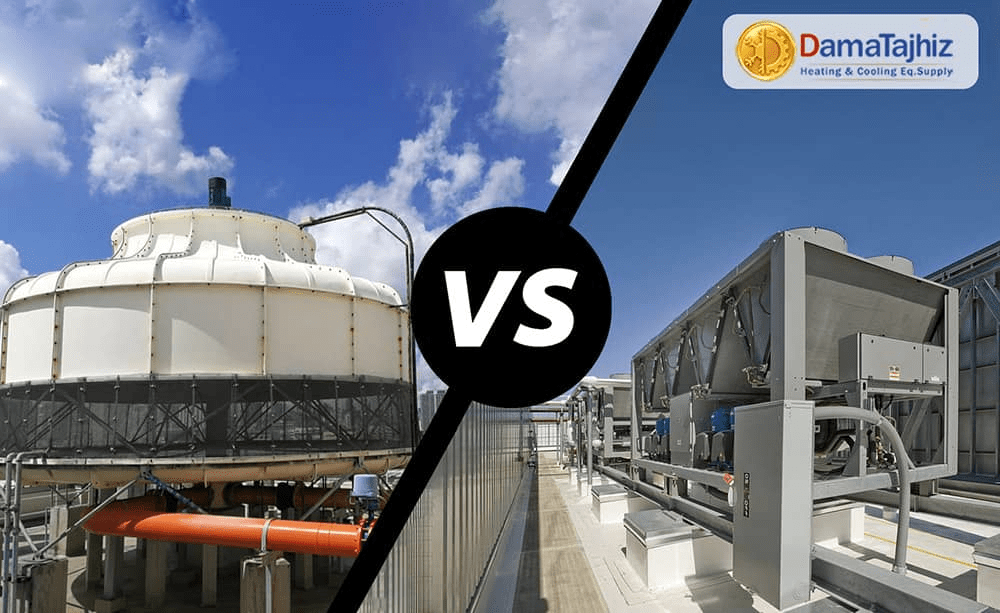Today, all the pieces of equipment that are produced and supplied in the field of air conditioning play a colorful role in creating the well-being and comfort of the residents of residential, office, commercial, etc. environments. A chiller and cooling tower are two common examples of equipment that are used to provide cool water for air conditioners and fan coils. In this article, the difference between a chiller and a cooling tower is discussed. Please stay with us to learn more about the operation and use of these two devices.
Click to view brands, models, and different types, find out the price, and Buy A chiller.

Definition of chiller and cooling tower
Before getting acquainted with the structure, components, operation, etc. of chillers and cooling towers, we will briefly define chillers and cooling towers and their applications.
What is a chiller and what is its use?
The chiller is known as the central core of a cooling system with a refrigeration cycle that cools the ambient air by reducing the temperature of the water and the flow of cooled water in the coils of the fan coils or air conditioners by the circulator pump. The compression chiller cools the water temperature of the coils of air conditioners and fan coils during a refrigeration cycle by using Freon gas circulating in its system circuit and then sends this cool water to the coils of air conditioners through a pump. In terms of performance, chillers are divided into three categories: compression, absorption, and centrifugal.
What is a cooling tower and what is its use?
A cooling tower is a device that absorbs the heat of cooling water in industrial devices or air conditioning systems from the method of heat transfer along with mass transfer (evaporation) and cools it to a few degrees higher than the wet temperature of the place. In terms of operation, cooling towers are divided into two general types: open circuits and closed circuits.
How the cooling tower works
As mentioned above, cooling towers are divided into two categories regarding operation.
How an open circuit cooling tower works
The reason why this type of cooling tower is called an open circuit is that the water that is pumped to cool the tower flows in an open space inside the tower chamber and has direct contact with the atmospheric air because the water collides with the air. , a part of the water evaporates, it is also called an evaporative, wet, or wet cooling tower. The following pictures show examples of cubic and roundish open-circuit cooling towers of Damatajhiz.
Open circuit cooling tower components
The main components of the open circuit cooling tower are:
- Fiberglass or galvanized body
- Air circulation fan
- Electric motor
- Packings
- Pond or mattress (cooling water collection place at the bottom of the tower)
- Drip arrester (installed between the packing and the fan and prevents water particles from leaving the top of the tower)
- Hot water distribution system at the top of the tower (pipes and water spray nozzles)
How a closed circuit cooling tower works
Closed circuit cooling towers are divided into two types, cubic and round, in terms of body material, fiberglass, and galvanized.
Closed circuit cooling tower components
- air fan
- Heat exchange coil
- Hot fluid inlet to the coil tubes
- air intake
- Cooled fluid outlet
How the compression chiller works
Compression chillers are one of the main types of chillers, in which various reciprocating (piston), screw or screw, spiral or rotary, rotating or rotary compressors and the new type of centrifugal compressors are used.
On the other hand, compression chillers include three general categories: water compression chillers, air compression chillers, and centrifugal chillers. One of the main advantages of water compression chillers compared to air compression chillers is their lower price and higher efficiency. Of course, air compression chillers have other advantages such as compatibility with Sharjah weather conditions, the possibility of installation outside the engine room (possibility of installation on the roof, balcony, and any other space), and no need to use water to cool the refrigerant and condenser of the chiller.
Compression Chillers components
Compressor
the operator
condenser
body
pump
Expanded milk
Approximate capacity calculation
To calculate the required chiller capacity of the project, the nominal capacity and the actual capacity of the chiller should be carefully considered, especially the outside design temperature in the summer season in the chiller operation area. In general, the facility experts calculate the required chiller capacity in each project, which is based on the exact calculation of the total refrigeration load capacity, in addition to calculating parameters such as geographical conditions (Ambient Temperature) and summer design temperature, altitude above sea level, relative humidity. Weather, the type of building use (temperature inside the design), the type of materials used and the execution of the building facade, the direction of the building about the angle of the sun, the number of floors, and the surface of the building, the number of people and small and large electrical equipment inside the building and so on. .., pay attention to the volume of cold water required and sufficient reliability coefficients in chiller performance.
But if you want to use the possibility of calculating the number of chillers required by residential and office buildings in climatic conditions like Tehran, Mashhad, Karaj, Isfahan, Erbil, Kabul, Sulaymaniyah, Halba and other cities with similar weather in summer, you can consider the nominal capacity of 4 tons of refrigeration for every 100 square meters of the building. get. Also, before determining the final capacity and choosing the required chiller for your project, contact the experts of Dematahheiz Company for the final control of calculations and correct estimates of the cooling load, and the correct selection of the compression chiller required for the project.
How the absorption chiller works
Other important types of chiller in terms of performance are absorption chillers, the most important parts of which are condenser and evaporator, absorber, solution pump, refrigerant pump, control valves, thermostats, electrical panels, and chiller control circuits.
Also, absorption chillers are divided into four categories: hot water absorption chiller, hot water absorption chiller, direct flame absorption chiller, and steam absorption chiller. Of course, these types of chillers include single-effect, double-effect, and direct-fire absorption chillers based on the way they work.
You can also read the article THE DIFFERENCE BETWEEN AIR COOLED CHILLER AND WATER COOLED CHILLER for more information.
Conclusion
In this article, we tried to provide useful information regarding the comparison of chillers and cooling towers. Chillers are known as the beating heart of an air conditioning system, and cooling towers are devices that absorb the heat of cooling water in industrial devices or air conditioning systems from the mass transfer method and transfer it to the atmosphere. To buy this equipment, you should pay attention to the use of the building, the size of the installation site, the capacity of the equipment, etc.
Final speech
Demataheheez specialized collection (the first and most reliable source for buying building facilities equipment and all air conditioning devices, since 2013 and has 3 valid business licenses), all kinds of chiller and cooling tower devices, and hundreds of other products with the guarantee of the originality of the product, valid warranty and Offers a reasonable price. For more information, you can contact the heating equipment experts by phone number: 021-88822550.

We are waiting for your call and look forward to meeting you at the DAMATAJHIZ group
By sharing the above article on social networks, let your friends know about its important content.

